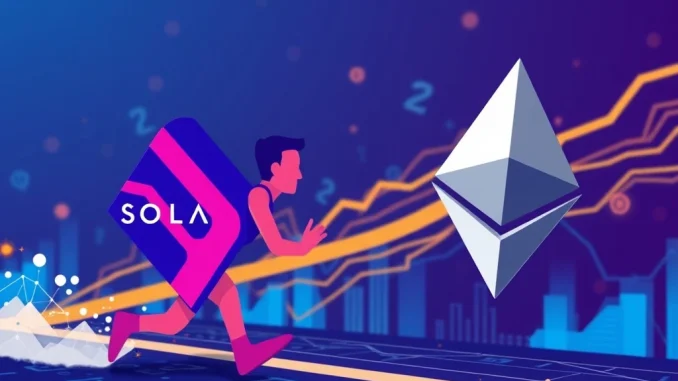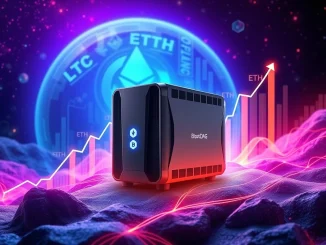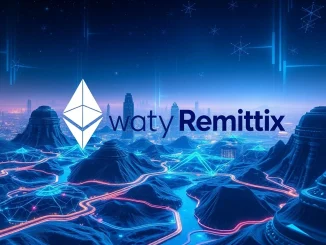
The cryptocurrency world is no stranger to bold predictions, but when a leading executive from a major crypto ETP issuer speaks, the market listens. Adrian Fritz, the astute Head of Research at 21Shares, has recently made waves with a striking Solana price prediction: he believes Solana (SOL) is poised to outperform Ether (ETH) throughout the remainder of this year. This isn’t just a casual remark; it’s a strategic outlook that challenges the established hierarchy and offers a fresh perspective on the evolving digital asset landscape. But what exactly underpins this audacious forecast, and what does it mean for investors navigating the volatile crypto seas?
Decoding the Solana Price Prediction: A Strategic Outlook
Adrian Fritz’s conviction in Solana’s superior performance isn’t born out of thin air. While acknowledging Ethereum’s mature ecosystem and undeniable dominance, Fritz points to several key factors that he believes give Solana a significant edge. He notes that Solana, despite its comparatively smaller stature, possesses a vibrant and highly active developer community. This isn’t just about lines of code; it’s about a community that is notably more “business-minded.” This implies a focus on practical applications, user adoption, and ecosystem growth that directly translates into tangible value.
Consider the recent surge in meme-related activity on the Solana blockchain in January. While often dismissed as speculative froth, this activity demonstrated Solana’s network efficiency, low transaction costs, and ability to handle high throughput, attracting a new wave of users and developers. For Fritz, this wasn’t just a fleeting trend; it was a testament to Solana’s underlying capabilities and its potential to capture significant market share.
The Ether vs Solana Showdown: A Deeper Dive into Ecosystems
The comparison between Ether (ETH) and Solana (SOL) is a tale of two different approaches to blockchain development and scalability. Ethereum, the pioneering smart contract platform, boasts a vast and deeply entrenched ecosystem with thousands of decentralized applications (dApps), extensive liquidity, and a long track record. Its move to Proof-of-Stake (PoS) with the Merge and subsequent upgrades like Dencun aim to enhance its scalability and efficiency.
Solana, on the other hand, entered the scene with a focus on speed and low costs, utilizing a unique Proof-of-History (PoH) consensus mechanism alongside PoS. This design allows it to process transactions at lightning speeds and for fractions of a cent, making it highly attractive for high-frequency applications, gaming, and now, meme coins.
Key Differences in the SOL ETH Comparison:
- Maturity and Ecosystem Size: Ethereum has a decade-long head start, resulting in a much larger and more diverse ecosystem of dApps, DeFi protocols, and NFTs. Solana is newer but growing rapidly, especially in areas requiring high throughput.
- Transaction Speed and Cost: Solana consistently boasts significantly faster transaction finality and lower fees compared to Ethereum, even after its upgrades. This is a critical advantage for certain use cases.
- Developer Philosophy: As Fritz highlights, Solana’s developer community is often seen as more agile and focused on practical, business-oriented solutions, perhaps due to its leaner, faster infrastructure.
- Decentralization vs. Efficiency: Ethereum is generally considered more decentralized due to its larger number of validators. Solana, while decentralized, has faced criticism regarding its validator distribution and past network outages, though it continues to work on improving this aspect.
A Snapshot Comparison:
| Feature | Ethereum (ETH) | Solana (SOL) |
|---|---|---|
| Consensus Mechanism | Proof-of-Stake (PoS) | Proof-of-History (PoH) + Proof-of-Stake (PoS) |
| Transaction Speed (TPS) | ~15-30 (Layer 1, more with Layer 2s) | ~65,000 |
| Transaction Cost | Higher (Gas Fees) | Significantly Lower |
| Ecosystem Maturity | Highly Mature, Vast | Rapidly Growing, Emerging |
| Developer Focus | Robust, Academic, Broad | Business-Minded, Agile, Performance-Driven |
| Centralization Concerns | Less, but debated | More, due to validator requirements |
Is the Ethereum Team Truly Complacent?
Fritz’s assertion that the Ethereum team has grown “complacent” is a provocative one. While Ethereum remains the dominant smart contract platform by market capitalization and Total Value Locked (TVL) in DeFi, its development pace can appear slower compared to agile newcomers. The Ethereum Foundation and its core developers are known for their meticulous, research-driven approach, prioritizing security and long-term stability over rapid deployment.
However, this deliberate pace can sometimes be perceived as complacency, especially by those advocating for faster innovation. Ethereum has faced persistent challenges with high gas fees and network congestion, leading to the rise of Layer 2 scaling solutions like Arbitrum and Optimism. While these solutions are thriving, they add complexity for users and developers. The Dencun upgrade, for instance, introduced ‘proto-danksharding’ to reduce L2 transaction costs, a significant step, but it took years to implement.
From Solana’s perspective, its rapid iteration and willingness to embrace new use cases (like the aforementioned meme coin surge) might seem more dynamic. Fritz’s comment likely stems from this contrast in development philosophy and market responsiveness.
Navigating the Crypto Market Forecast: What Does It Mean for Investors?
A crypto market forecast like this from a respected figure like Adrian Fritz can significantly influence investor sentiment. For those holding both SOL and ETH, or considering new positions, such a prediction prompts a re-evaluation of investment strategies.
Actionable Insights for Investors:
- Diversification is Key: Relying on a single asset, even a promising one, carries inherent risks. A balanced portfolio across different blockchain ecosystems can mitigate potential downsides.
- Understand the Fundamentals: Don’t just follow predictions. Research the underlying technology, developer activity, ecosystem growth, and use cases of both Solana and Ethereum.
- Evaluate Risk vs. Reward: Solana, being a smaller project, inherently carries higher risk but also potentially higher reward if it achieves significant growth. Ethereum, while more mature, might offer more stable, albeit potentially slower, returns.
- Monitor Development Roadmaps: Keep an eye on both Ethereum’s upcoming upgrades (e.g., Verkle Trees, full sharding) and Solana’s continued efforts to enhance decentralization and network stability.
- Consider Network Effects: Ethereum benefits from strong network effects due to its vast user base and dApp ecosystem. Solana is building its own network effects, particularly in areas where speed and low cost are paramount.
Challenges and Considerations: Beyond the Hype
While the bullish case for Solana is compelling, it’s crucial to address its challenges. The primary concern often cited is its relative centralization compared to Ethereum. Solana’s hardware requirements for running a validator are higher, leading to fewer independent validators and raising questions about censorship resistance and network control. Additionally, Solana has experienced several significant network outages in the past, though the team has made considerable efforts to improve stability.
For Ethereum, the challenges revolve around its scalability at Layer 1 and the complexity introduced by Layer 2 solutions. While L2s are powerful, they fragment liquidity and user experience to some extent. The ongoing debate about Ethereum’s “bloated” state and its resource intensity also persists.
Adrian Fritz acknowledges Solana’s more centralized nature but still believes it will hit new highs this year. This suggests that for 21Shares, the trade-off between efficiency/growth potential and perfect decentralization is acceptable, at least for the current market cycle.
Conclusion: A Dynamic Future for Digital Assets
Adrian Fritz’s bold Solana price prediction injects an exciting narrative into the ongoing Ether vs Solana debate. While Ethereum remains a formidable force with its established ecosystem and ongoing innovations, Solana’s aggressive growth, active developer community, and focus on high-throughput applications position it as a serious contender. The SOL ETH comparison isn’t just about market caps; it’s about competing visions for the future of decentralized technology.
Whether Solana truly outshines Ether this year remains to be seen, but Fritz’s insights from 21Shares research underscore the dynamic and competitive nature of the crypto space. For investors, this highlights the importance of staying informed, understanding both the potential and the pitfalls, and making decisions based on thorough analysis rather than just hype. The journey of both SOL and ETH will undoubtedly continue to shape the broader crypto market forecast for years to come.



